Travel in Czechoslovakia and Yugoslavia
RAILWAYS OF EUROPE - 27
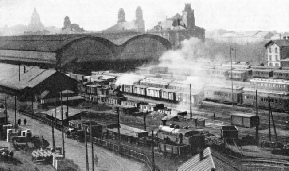 WILSON STATION at Prague is the largest passenger station in Czechoslovakia. The above illustration, taken from behind the terminus, shows that part of the building which accommodates trains arriving from the east and north of Czechoslovakia.
WILSON STATION at Prague is the largest passenger station in Czechoslovakia. The above illustration, taken from behind the terminus, shows that part of the building which accommodates trains arriving from the east and north of Czechoslovakia.
AN important effect of the war of 1914-18 was the formation of new states out of the wrecks of former empires. This chapter will deal with railways in the republic of Czechoslovakia and in the kingdom of Yugoslavia, the former entirely and the latter largely formed out of fragments of the former Austro-Hungarian Empire. Neither country had, as such, an independent existence before the war, although Yugoslavia includes the prewar kingdoms of Serbia and Montenegro.
Czechoslovakia is a country in the heart of Europe, and extends from west to east for a distance of about 620 miles, in the form, roughly, of a wedge, with the narrow end to the east. The greatest width of the wedge is some 160 miles, and the narrowest thirty-one miles. The country is bordered on the west and north-west by Germany, on the north by Poland, and on the south by Austria, Hungary and Romania. Nearly all the railway mileage of 8,400 is of standard gauge operated by the State, which owns most of the lines. About 1,250 miles belong to private companies, but are operated by the government. The area of the republic is 54,900 square miles, and the population at the 1930 census was 14,726,000. The capital, Prague (Praha), had nearly 870,000 inhabitants in 1932.

4-6-2 TANK LOCOMOTIVE in service in Czechoslovakia. The cylinders measure 18 in by 28 in, and the coupled wheels have a diameter of 5 ft 3 in. Total heating surface of the locomotive, including superheater, is 1,171 sq ft, and the area of the fire-grate is 21½ sq ft. The speed indicator is of the “Haushaelter-Reszny” type, with automatic recording. It is fitted to the right side of the cab wall and worked from the rear coupling rod.
Although Czechoslovakia was founded as late as October 28, 1918, ten days after independence had been proclaimed, part of it, the Czech portion, was founded as the State of Bohemia over a thousand years ago. The republic is inhabited by people of various races - Czechs, Slovaks, Ruthenians, Germans, Hungarians, Poles, and Romanians. The western part, Bohemia and Moravia-Silesia, was included in the Austrian part of Austria-Hungary before the war; the eastern part, comprising both Slovakia and Carpathian Ruthenia, was the northern mountain region of Hungary. The country is now divided into these four provinces.
Before the war of 1914-18 the great railway centres in this part of Europe were Prague, Vienna, and Budapest. The comm-unications between west and east in the new state were therefore indifferent. The new state decided to forge railway links to accord with the altered conditions, and to alter the trend of internal communications so as to flow towards Prague and not towards the other two cities, which are now the capitals of two other countries.
In 1919 the Czechoslovak State Railways took over 3,424 locomotives, rather more than half the Austrian locomotive stud of 1913, and added another 674 when it acquired certain private railways. The latest returns give the following figures: 7,230 locomotives, 34 electric locomotives, 420 motor rail-cars, 9,240 carriages, 99,980 wagons and 540 mail vans.
Because of the hilly nature of much of the country only 22 per cent of the lines are on level ground; 22 per cent of the lines have gradients of between 1 in 100 and 1 in 40, while the remainder are between level and 1 in 100.

THE MAIN LINES of Czechoslovakia and Yugoslavia are shown here, together with those of Hungary. In Czechoslovakia there are altogether some 8,400 miles of track. The Hungarian State lines have some 4,800 miles in operation. Yugoslavia has some 4,400 miles of standard gauge and 1,940 miles of narrow-gauge track.
Of the principal traffic coal products, including coke, occupy the first place, accounting for more than 38 per cent. About half of the lines have the character of mountain railways. For the purposes of building, maintenance, and inspection, the permanent way is divided into 126 track-maintenance sections, and eight permanent way managements (for the local lines), there being one district management for about sixty-two miles of track.
The maintenance centres are under the control of station-masters, and it is their duty to keep in order sections of between nine and eighteen miles according to the speed and intensity of the traffic. Each station-master’s section is divided into two or three sections under line-keepers, who supervise the work gangs of between nine and eleven men. The inspection of permanent way on stretches of track where the maximum speed is thirty-one miles an hour is carried out regularly by the permanent way inspection department, as on these lines there are level crossings without barriers. On stretches of track where the maximum speed is above this limit, there are barriers, the manipulation of which is arranged so that the duty can be carried out from one line-keeper’s station; this arrangement is being simplified by bridges and subways to avoid level crossings.
The network of lines in Bohemia and Moravia-Silesia is the third closest in Europe, ranking after England and Belgium. But before the war the lines of the whole country were unevenly distributed. The lines in the west, which were formerly those linking Vienna and Budapest, were well built and maintained, while those running from east to west were neglected. All the workshops, except two in Slovakia, were in that part of the country which belonged to Austria. It was considered best, when the new state came into being, not to close the existing workshops, but to improve them, to build new workshops at Trnovo, in Slovakia, and to apportion the work to the establishments. Sixteen workshops comprise the establishment.

2-10-2 SUPERHEATED TANK. This Czechoslovak locomotive has five coupled axles, of which the centre one is the driving axle. The cylinders measure 24 in by 22 in, and the coupled wheels have a diameter of 4 ft 1 in. The total heating surface amounts to 2,162 sq ft and the boiler pressure is 191 lb per sq in.
In the west the country is industrial, and has the traffic conditions of industrial areas, while the east is mainly agricultural. The west contains the famous spas of Karlovy Vary (Carlsbad) and Marianske Lazne (Marienbad). There are also a number of other spas in this district, which is on the southern slopes of the Ore Mountains in northwest Bohemia. Jachymov (St. Joachimsthal) is a new spa which is being developed. In Moravia there are spas at the foot of the Beskids; there are also spas in Silesia and Slovakia. The springs of sulphurous water are warm in Slovakia and cold in Moravia.
Karlovy Vary, some seventy miles from Prague, has been famous for hundreds of years. In the season special luxury trains converge upon it from Paris, Brussels, Berlin and Vienna, and through carriages run from Warsaw, Bucharest, Budapest, and Belgrade.
The main line from Berlin and Dresden enters the country at Podmokly (Bodenbach), which is eighty miles from the capital, and follows the valley of the Elbe. At Usti Nad Labem the River Bela joins the Elbe. Near Lovosice the Elbe takes a big bend; the railway does not follow this, but goes on, crossing another river, the Ohre, and regains the Elbe at Roudnice. It now follows the Elbe through a fertile plain to Dolni Berkovice, where it leaves the Elbe, and gains the River Vltava beyond Vranany. The Vltava is the river that flows through Prague.
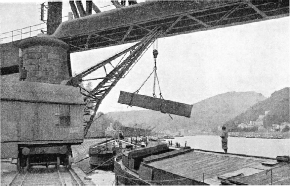
ON THE RIVER ELBE. A view of Decin, an important industrial town in the north of Bohemia. Decin is a big transhipment station for river transport to the northern ports, and both the railway and river combine here to serve the home industries.
The line continues along the valley, and at Kralupy is joined by a branch from the anthracite coal-mines at Kladno-Slany. The line follows the river almost into Prague, but does not follow the sweep which the river makes before it enters the city.
On the other bank of the Elbe is the line which connects with the route to Dresden and Berlin. This line runs from Decin, parallel with Podmokly, and is nearly four miles longer. It follows the Elbe after the other line has left the river, and does not leave it until reaching Neratovice, where it climbs towards the watershed of the Vltava, and enters Prague after describing a long curve.
Cheb, lying close to the German frontier, is reached by trains from Paris and Nurnberg. It is 138 miles west of Prague, and is the junction for a number of lines, including those to the two famous spas of Karlovy Vary and Marianske Lazne, which are respectively north-east and south-east of it. The town lies on the south bank of the River Ohre. The shortest route from Cheb to Prague passes through Marianske Lazne and Plzen. The track rises from the valley of the Ohre to reach Marianske Lazne, and descends sharply to cross the River Mze. Plzen, better known as Pilsen, on the River Mze, is a city of over 120,000 inhabitants, and the industrial centre of West Bohemia and its coalfields. Its breweries are world-famous. Beyond Plzen the track leaves the river, and climbs and descends the wooded Brdy Hills, and regains the River Mze, now called the Berounka, which it crosses just before the river flows into the Vltava at a point near Prague.
A Link with Germany
The line from Cheb through Karlovy Vary to Prague is 150 miles long. It follows the River Ohre, passes through Karlovy Vary, and leaves the Ohre after Zatec. It gains Prague after passing a region of coal-mines and ironworks.
Plzen has another outlet to Germany by way of Furth, on the German side of the frontier, this line being fifty miles long, and tapping a region of coalmines and glassworks.
A line from Ceske Velenice, south of the capital and on the Austrian border, goes to Prague, entering the country and pro-ceeding through a region of meadows and fish-ponds. At Mezimosti-Veseli the line is joined by another from Homi-Dvoriste, on the Austrian border, while farther north, at Tabor, is a junction with lines from Plzen and other towns on the network south of the capital. The line goes north to Prague. From Ceske Velenice another line goes north-west to Plzen, affording lovely views of the mountains.
Bratislava (Pressburg), with a population of 143,000, is the capital of Slovakia and a port on the River Danube. It lies close to the borders of Austria and Hungary. A section of the railway runs near the border from Breclav, which is north of Bratislava, to Szob, a Hungarian town to the southeast of Bratislava. On the Czechoslovak side of the boundary is the station of Parkan. The line leaves the Danube and climbs to an upland plain; part of the line is on the route of the “Orient Express” between Vienna and Budapest.
The next link northward is the line from Breclav through the second largest city in the country, Brno (Brunn), with a pop-ulation of 264,000. Brno, capital of Moravia-Silesia, is the centre of the woollen textile industry, and has several routes linking it with Prague. The line continues north after Brno, and goes to Ceska-Trebova, soon after which it turns west for Prague, which it gains after crossing spurs of the Iron Mountains.
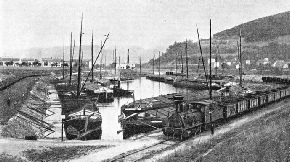
THE TRANSHIPMENT STATION of Usti-nad-Labem in Northern Bohemia is also an important centre for transferring goods from the railway to barges on the River Elbe. From Usti-nad-Labem goods can travel by water to the city of Hamburg, in Germany.
Kosice, in the east, is a city of 70,000 inhabitants, and an important railway centre. A line goes east to Kralovo, and another goes west to the mountain resorts of the Tatras. One section ends at Liptovsky Sv. Mikulas, and another goes on farther to Bohumin, on the Polish-German frontier, where connexion is made with trains from Germany and Poland. To the west in the direction of Prague the network is dense.
The lines from Bohumin east to Kosice and farther east to Jasina, at the thin edge of the wedge formed by the country, are being used to open up tourist traffic in northern Slovakia and the east of the country, the centre for the section of the railways being Kosice.
Zilina, commercial centre of the northern part of central Slovakia, is the starting point for the tour, and the train goes along the valley of the Vah. Tourists take narrow-gauge lines into the mountains, returning to the main line. This part of Europe is little known to Britons and Americans, and is off the beaten track; but by the aid of the railway, funicular lines, and rail-cars it has been made accessible. New paths have been opened up not only in the mountains, but also in the wooded districts of the centre of the country. There are the mountain chains which form the frontiers: in the southwest the Bohemian forest, in the northwest the Ore Mountains, in the north the Giant Mountains, the Beskids, and the Carpathians. The central hills include the country of the Bohemian-Moravian border, the Little and White Carpathians on the Moravian-Slovakian border, the Javomik Mountains in the heart of Slovakia, the Little Tatras and the Slovakian Ore Mountains and the Tatra Chain. The Beskids form the foothills of the High Tatras.
In the Carpathians
The great forests of the Carpathians in the east of the country are only just being penetrated, and the district is old-world, and has a charm of its own. In these regions the wolf and the bear make their home, and the people dress in their national costumes on Sundays, and preserve their folk-songs and their local crafts. This is a part of the world which remains individual and not standardized.

TWO-CYLINDER SUPERHEATED GOODS LOCOMOTIVE in operation on the State lines of Czechoslovakia. Built to work on standard gauge track, this 2-10-0 engine has cylinders 24 in by 25 in, and driving wheels of 4 ft 3 in. The total heating surface, including superheater, is 3,638 sq ft. The working pressure is 205 lb per sq in. The locomotive is fitted with a Westinghouse brake and has a special sprinkling device for coal.
Yet in the western part of the country there are industrial cities, the products of which are sent to the ends of the earth. Pilsener lager, for instance, is famous, and in recent years the Bata shoe factories at Zlin have achieved international renown not only for their wares, but also for a system of industrialization which is to Europe what the Ford system is to the United States. The Skoda works, which produce steam and electric locomotives at Plzen, have long been famous, and the glass-ware and steel in this part of the country have played their part in the industrial history of Europe. About forty per cent of the inhabitants of the country depend on agriculture. Bohemia and Moravia, however, acquired about three-quarters of the former Austrian industries when the republic was formed.
A private company operates the Tatra Railway in the High Tatras, connecting with the State Railways at Poprad Vel’ka, and for Stary Smokovec and on to Strbske Pleso and for Tatranska Lomnica. From Stary Smokovec a funicular railway over a mile long goes up to a hotel, and a toboggan run has been made alongside the track. The railway owns the hotel which is the starting point for tours in the mountains.
The railways of the State are divided into the following seven divisions: Prague, Plzen, Hradec Kralove (east of Prague), Brno, Olomouc (north of Brno), Bratislava, and Kosice. The largest passenger station in the country is the Wilson Station at Prague, which was named after President Wilson.
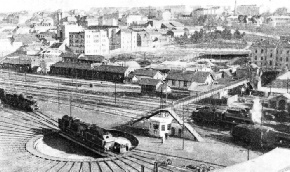
IN BELGRADE. A view of the locomotive depot and of a new turn-table outside the engine-sheds. The Yugoslav capital is on a vital trunk line between Western Europe and the Near East.
The first railway to be built after the State began its programme of improvement was a line twenty-one miles long between Zvolen and Krupinek, in Slovakia. This runs through the valleys of the rivers Njeresnica and Krupinica, and crosses their watersheds at a height of 1,400 ft above sea-level. Another line, twenty-four miles long, was the Vsetin-Bylnice-Brumov line, connecting Moravia with Slovakia. This was opened in October, 1928, as part of the festivities to mark the first ten years of the republic. It was called the President Masaryk Line. The line from Veseli Nad Moravou to Nove Mesto Nad Vahom is forty-two miles long, although the distance is only thirty miles as the crow flies. There are a number of tunnels and bridges, the General Stefanik tunnel being 2,647 yards in length. This line was opened in 1929. Other lines are being constructed.
Although the country is far from the sea, there are two international waterways, the Danube and the Elbe, and the river ports are busy. The railways send goods at reduced rates to these towns, and the goods are loaded into barges and other craft and taken to Hamburg, on the Baltic, or down the Danube to the Black Sea.
Prague is little more than a day’s journey from London; the express service by way of Ostend takes twenty-eight hours, but in summer a luxury train, with through sleeping cars from Calais to Prague reduces the time from London to twenty-six hours; this train has through carriages for Karlovy Vary, detached at Cheb.
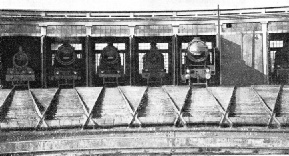
AN ENGINE ROUND-HOUSE IN YUGOSLAVIA. This illustration shows a section of the principal engine round-house in Belgrade. The lines can be seen leading on to the edge of the turn-table shown above. There are some 1,760 standard gauge and 260 narrow gauge locomotives operating on the lines of Yugoslavia.
YUGOSLAVIA is also a most interesting country, and is a land of many contrasts, having the colour of the Near East and the travelling comforts of the West. It is the country of the Serbs, Croats, and Slovenes, or South Slavs, and came into being as a result of the war. The area is about 94,200 square miles, and the population in 1931 was 13,934,000.
Yugoslavia comprises the former kingdoms of Serbia and Montenegro, large areas of what was once Austria-Hungary, and a small part of pre-war Bulgaria. The Adriatic Sea forms one boundary, and the bordering countries are: to the north-west, Italy and Austria; to the north, Hungary and Romania; to the east Bulgaria, and to the south, Greece and Albania.
Belgrade, or Beograd, now a city of 291,700 people, is the fine capital arisen above the battered ruins which were left after the war. The greater part of the city is new, and it is the railway centre of southeastern Europe. Belgrade has been for centuries a vital point on the highway between Europe and Asia. Its history has been stormy, and for a long time it was in the hands of the Turks. The name means the “White City”; it is situated at the confluence of the River Save or Sava and the great waterway of the Danube. Another important river in the country is the Drave or Drava, also a tributary of the Danube.
 2-8-4 EXPRESS LOCOMOTIVE for heavy traffic work on the Czechoslovak State Railways. This powerful engine has cylinders measuring 21½ in by 26 in, and the diameter of the driving wheels is 5 ft 10 in. The working pressure of the locomotive is 235 lb per sq in. The designed maximum speed is just under 70 miles and hour.
2-8-4 EXPRESS LOCOMOTIVE for heavy traffic work on the Czechoslovak State Railways. This powerful engine has cylinders measuring 21½ in by 26 in, and the diameter of the driving wheels is 5 ft 10 in. The working pressure of the locomotive is 235 lb per sq in. The designed maximum speed is just under 70 miles and hour.
The nine districts, or Banovinas, into which, tor administrative purposes, the country is divided, are as follows: Dunavska (Danube) Banovina, with its seat of administration at Novi Sad, including the Vojvodina up to the Slavonian frontier and north-western Serbia as far as the Morava valley. This district is served by the railways of the Subotica Division, and is bordered on the north by Hungary, on the east by Romania, and on the south by the Danube. It is a rich agricultural province, producing maize, wheat, barley, hops, sugar beet, and grapes. The Moravska Banovina, with its chief town at Nish (Nis), includes the Morava valley to the Bulgarian frontier. The Drinska Banovina, has its seat in Sarajevo, and is composed of parts of Bosnia and Srem. The Zetska Banovina (seat of administration Cetinje), contains Montenegro, parts of Hercegovina, the Sanjak of Novi Pazar, Southern Dalmatia, and Western Old Serbia. The Primorska (Littoral) Banovina has its seat at Split (Spalato), and includes northern Dalmatia, part of the Croatian littoral, and parts of Hercegovina and Lika. The Vrbaska Banovina (headquarters Banka Luka) is composed of northern Bosnia, parts of Croatia and the northern Lika. The Savska (Save) Banovina, with its headquarters at Zagreb, is composed of the northern littoral, other parts of Croatia, and parts of the Lika and Slavonia, and extends from the coast across the country.
The Dravska (Drave) Banovina (headquarters Ljubljana) forms the north-west province, and roughly comprises the territory of Slovenia. At the other end of the country, in the southeast, is the Vadarska Banovina, with its seat at Skoplje, a town on the railway from Nish to Salonika. This province is composed of Serbian Macedonia and part of old Serbia, and is bounded by the Bulgarian, Greek, and Albanian frontiers. The capital, Belgrade, is a separate administrative unit.
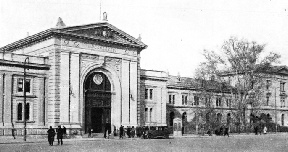
A RAILWAY TERMINUS AT BELGRADE, the capital of Yugoslavia. Belgrade constitutes the chief railway centre of south-eastern Europe. Except for a few private lines, all the railways of Yugoslavia are owned by the State. The main lines are of standard gauge, but, in addition, tracks of 1 metre, 2 ft 6-in, and 2 ft have been widely laid.
Because Yugoslavia has been formed out of several countries, the railways taken over after the war were of mixed origin; much has been done to unify them. The main lines are of standard gauge, but tracks of three gauges - 1 metre, 2 ft 6-in, and 2 ft - are found extensively, especially in mountainous districts where they have been built principally to develop the tourist traffic.
As about four of every five persons in the country derive their livelihood from the soil, being peasant farmers, Yugoslavia is not an industrial country. But the country is in process of change, as much of the Oriental aspect has become westernized in the last few years.
Post-War Reconstruction
The Austrians built most of the lines in the country. In what was formerly Serbia, the main line from Belgrade to Nish was built in 1884, and other lines were built later. The railway from Nish to Salonika - now an important port in Northern Greece - was Serbia’s only direct outlet to the sea, and played its part in the complications of Balkan politics. Practically all the railways in Serbia were destroyed during the war, and railway reconstruction was among the first tasks to be attempted when the new country of Yugoslavia emerged.
From England to Yugoslavia, the traveller has a variety of routes, of which that followed by the “Simplon-Orient Express” is one of the most popular. This train, starting from Calais, runs via Paris, Milan, Venice, and Trieste. Other luxury trains serving the country are the “Arlberg-Orient”, the “Orient”, and the “Ostend-Vienna-Orient” expresses, all of which connect with expresses to Belgrade and beyond from Budapest.
Entering Yugoslavia from the northwest and north are a number of lines which lead to Zagreb (previously known as Agram), the former capital of Croatia, and the second city in the country. Its population is 206,000, which is not much less than that of the capital. Zagreb is on the border of Western and Eastern Europe. It is the capital of the Savska Banovina.
The State Railways are divided into five divisions or districts: Belgrade, Zagreb, Ljubljana (west of Zagreb), Sarajevo (in the centre of the country), and Subotica, north of Belgrade.
Ljubljana (Laibach) is the main-line centre for the Slovenian health resorts of Bled and Bohinj, and for the spas. It is the third city in the country, and lies in the midst of Alpine scenery. At Bled, the summer residence of the Yugoslav royal family, the Duke of Kent met Princess Marina of Greece and Denmark. Lake Bled is in the Slovenian Mountains, and from the shores of the lake can be seen the snow-capped peaks of the Julian Alps. Ljubljana is the focal point of a number of lines. There are the line coming into Yugoslavia from Munich, and the line from Trieste, while the main line to Belgrade and Zagreb strikes away to the east. At Zidani Most, on the line to Zagreb, a branch runs north-east and bifurcates, one fork going to Vienna, and the other to Budapest.

ROTARY SNOW-PLOUGH in use on the State lines of Yugoslavia. The railways possess 4,200 carriages and 47,000 wagons on the standard gauge lines, and 760 locomotives, 970 carriages, and 12,000 wagons on the narrow-gauge lines.
Zagreb has railway connexions with all parts of the country, for it is not only on the main line of the Yugoslav system, but it is also a junction for the lines that come down from Hungary to the Adriatic ports of Trieste, Susak, and Split.
Brod, a station on the main line to Belgrade, is the junction for the line that goes south to the coast, terminating at Dubrovnik (Ragusa). On this line is Sarajevo, junction for a branch that runs east, joining the main line between Belgrade and Nish, and having various spur lines.
From Vinkovci, on the main line, a branch goes north to Subotica, where it joins the main line from Budapest to Belgrade, used by the “Orient Express” and other international trains. The Yugoslav main line meets the Budapest-Belgrade line at Novi Sad, and proceeds to Belgrade. Farther on, at the important junction of Nish, or Nis, the main line divides, one section going east to Sofia and to Istanbul, and the other to Salonika, and through Greece to Athens. Thus the three main cities of the country, Belgrade, Zagreb, and Ljubljana, are on this main trunk line, and are reached easily from any part of Europe.
When the country came into being the railway administration did not have to alter the whole direction of traffic as had some other newly-created countries of Europe. The task was rather to repair damaged lines, and to fill in a number of gaps in the system of narrow-gauge lines and link them with the trunk line. Because of the mountainous nature of much of the country, some of these narrow-gauge lines were built to open up the country for tourists, and not to carry goods, and such routes are spectacular. The coast-line is beautiful, and is protected by chains of lovely islands, and has many quaint cities and ports. It is well served by steamships, and it would probably not pay to build a line along the whole of the coast.
Dubrovnik (Ragusa), which is linked by rail with the trunk line, is one of the most beautiful cities of the Adriatic, and was at one time a tiny state which became known as the Slav Athens, with a culture of its own, so far advanced that slave-trading was forbidden, and profiteers were punished.
The line from Dubrovnik goes to Sarajevo through Mostar, a town which retains its Oriental character, as many of the inhabitants of this part of the country are Moslems.
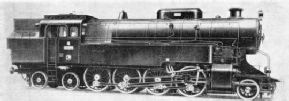
EXPRESS TANK ENGINE in service on the Czechoslovak State lines between Prague and Budejovice. The cylinders measure 23 in by 28 in and the diameter of the driving wheels is 5 ft 2 in. The working pressure of this 2-8-4 engine is 191 lb per sq in. The boiler is of a standard type with a large copper firebox having a grate area of 47 sq ft. This type of locomotive was first introduced at the beginning of 1928.
Sarajevo was once the capital of the Moslems of Bosnia, and is now the capital of the Drinska Banovina, and the centre of one of the five railway divisions. The city lies 1,762 ft above sea-level, and 24,000 of the 85,000 inhabitants are Moslems. It lies in the form of an amphitheatre on the River Miljacka, which forces its way through a gorge surrounded by high hills on all sides except the west. When the Turks invaded Bosnia, the Bosnians in the district fled to the protection of a fortress which had been built, and thus the town was founded. The narrow-gauge lines, of which Sarajevo is the centre, and the roads make it a popular resort for tourists, sportsmen, and climbers. It has another claim to fame which it does not advertise. It was in this picturesque place that the Austrian Archduke and his wife were assassinated in 1914, and this led to the outbreak of the war of 1914-18.
The line through Mostar from Dubrovnik to Sarajevo affords views of beautiful country. The line running east from Sarajevo through Visegrad and Uzice winds through some amazing gorges, the engineering work being among the most difficult tasks of construction undertaken by Yugoslavia. From Lasva, on the line from Sarajevo to the main-line station of Brod, a branch runs north-west via Jajce and Banja Luka. This branch is used by travellers to and from Zagreb, and it also links with the line from Split, on the coast, to Zagreb. Sarajevo has thus become an important junction. Moreover, lateral comm-unication has been established through Yugoslavia south of the trunk line, although some of the routes are necessarily devious as they have to traverse mountainous country.
Jajce, on the branch from Lasva, was once the seat of the old Bosnian kings. A river rushes through the town and falls in a cascade called the Pliva Falls. Banja Luka, which is a Moslem town, is claimed by some people to be the burial place of St. Luke. It is the commercial centre of the district.
Some of these narrow-gauge lines leading inland from the coast were built by the Austrians, who began to develop the Dalmatian coast before the war. In recent years the Yugoslavs have improved old lines, and built new ones to increase the tourist traffic. The tourist traffic was hit by the world depression, but the policy of opening up new districts and offering reduced fares is reaping its reward.

BUILT FOR HEAVY PASSENGER SERVICE in Czechoslovakia. This 2-8-0 engines has cylinders 23 in by 28 in, and the eight coupled wheels have a diameter of 5 ft 2 in. The grate area is 43 sq ft and the boiler pressure is 191 lb per sq in. All code head-lamps, as well as the cab lamps, are illuminated by acetylene gas.
One reduction is particularly interesting as it has been introduced to attract honeymoon couples. Newly-married couples are allowed to travel at half fares provided that they start within a fortnight, and complete their journey within a month of the wedding ceremony. Visitors to spas, watering places, and seaside resorts are allowed reductions on the fares for the return journey, which vary from half in the summer months, to three-quarters during the autumn and spring, while in the winter single fare covers the return journey.
Split (Spalato), the terminus of the line from Susak and Zagreb, is famous for the palace of the Roman Emperor Diocletian, and is busy and prosperous. Plitvice, on this line, is the centre for the lovely lakes of Plitvice. These are formed by the River Korana widening into a chain of lakes which descend by a series of limestone terraces to a deep gorge. Trains leave Split for Zagreb on this standard gauge line, with through carriages for Vienna, Prague, Cracow, and Bucharest. Split is thus in contact with the heart of Europe. The journey to Zagreb is through lovely scenery.
The line is joined at Ogulin by one from Susak, which is the port adjacent to Fiume. Fiume is Italian territory; Susak has been developed, and the Italian port has declined. Susak enables the Yugoslavs to send their produce by a standard gauge track to a port in their own territory, where it can be shipped in vessels of their nationality. It also provides Austria and Hungary with a port as an alternative to Trieste and Fiume, should they wish to avoid shipping goods through an Italian port.
Such a patchwork of contrasts in scenery, religion, and history is Yugoslavia that the question of railway communications and the improvement of the travelling facilities is of an importance outside the realm of economics.
This part of Europe is a land of communities which have separate individualities. But the provision of cheap railway transport enabling once-isolated communities to intermingle and receive impressions of places beyond their formerly restricted horizons will help them to realize that they are units in a country which has possibilities. Mosques and monasteries flourish almost side by side, and one section of the community looks to the east and the other to the west. One part of the country, the former kingdom of Montenegro, has no railway. The Yugoslavs are for the most part not engineers or factory workers, but prefer working on the land and growing crops.
Main Trunk Line
Entering the country from the northwest by the main trunk line, the traveller is in a mountainous district, which was formerly Austrian, bordering on the Tirol and the Venetian Alps. This is the land of the Slovenes, whose language differs from the Serbo-Croatian spoken elsewhere. The country has Alpine scenery, to which the State Railways is attracting tourists by developing the resorts for winter sports. The people in this part of Yugoslavia are industrious, and the principal local industries are iron and steel, textiles, paper, leather, and timber. There are also coal and lead mines.
The next province or Banovina through which the trunk line passes is that of Savska, with its fine city of Zagreb. The people are Croats, and this part of the country was long under the domination of the Hungarians. Slavonia, which lies to the east of it, was also under Hungary, and is a fairly level, well-timbered country producing good wood, which is used for furniture-making. Brod and Vinkovci, on the trunk line, are centres of the timber industry. Belgrade has had so many vicissitudes that ancient buildings are conspicuous by their absence, and the principal impression the capital gives is that of concrete, which has been employed in the building of the city.
The railways played an important part in the history of the Balkans in the troublesome period before the war of 1914-18. For political reasons, Austria did not desire to link certain systems, but this has been done by the Yugoslavs. There are now 4,400 miles of standard gauge lines, and many miles of narrow-gauge lines. There are of standard gauge some 1,760 locomotives, 4,200 carriages, and 47,000 wagons; on the narrow-gauge lines there are 760 locomotives, 970 carriages, and 12,000 wagons. Nearly all the railways are controlled by the State.
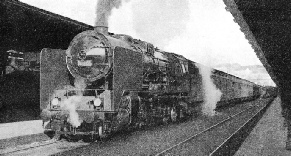
SEVERAL INTERNATIONAL EXPRESSES serve Yugoslavia. These include the “Simplon-Orient”, the “Orient”, the “Arlberg-Orient”, and the “Ostend-Vienna-Orient” expresses. The illustration shows a long-distance express at Belgrade.
You can read more on Czechoslovakian electrification in the chapter
“Electrification in Europe”
and you can read more on
“Austria’s Rail Transport”
and
“The Orient Express”
and
“Poland’s Main Lines”
on this website.


 WILSON STATION at Prague is the largest passenger station in Czechoslovakia. The above illustration, taken from behind the terminus, shows that part of the building which accommodates trains arriving from the east and north of Czechoslovakia.
WILSON STATION at Prague is the largest passenger station in Czechoslovakia. The above illustration, taken from behind the terminus, shows that part of the building which accommodates trains arriving from the east and north of Czechoslovakia.







 2-
2-



